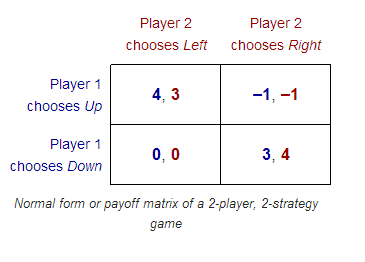- Beranda
- Komunitas
- News
- Sains & Teknologi
Apa itu Game Theory ? Apa kegunaannya ?
TS
Kovalski
Apa itu Game Theory ? Apa kegunaannya ?
Quote:
Dulu sempet ada bahasan game theory, tapi sekarang gak bisa dibuka. ane search juga gak ada gan
sebenernya teori ini penting dalam beberapa bidang.
Siap-siap hypertext gan
Translate nanti ya gan !
sebenernya teori ini penting dalam beberapa bidang.
Siap-siap hypertext gan

Translate nanti ya gan !
Status :In Construction
PART I : Definition And Types
Quote:
Game theory is a study of strategic decision making. Specifically, it is "the study of mathematical models of conflict and cooperation between intelligent rational decision-makers". An alternative term suggested "as a more descriptive name for the discipline" is interactive decision theory. Game theory is mainly used in economics, political science, and psychology, as well as logic and biology. The subject first addressed zero-sum games, such that one person's gains exactly equal net losses of the other participant or participants. Today, however, game theory applies to a wide range of behavioral relations, and has developed into an umbrella term for the logical side of decision science, including both humans and non-humans (e.g. computers).
Quote:
Game theory is the branch of decision theory concerned with interdependent decisions. The problems of interest involve multiple participants, each of whom has individual objectives related to a common system or shared resources. Because game theory arose from the analysis of competitive scenarios, the problems are called games and the participants are called players. But these techniques apply to more than just sport, and are not even limited to competitive situations. In short, game theory deals with any problem in which each playerís strategy depends on what the other players do.
Spoiler for GT:
Quote:
Modern game theory began with the idea regarding the existence of mixed-strategy equilibria in two-person zero-sum games and its proof by John von Neumann. Von Neumann's original proof used Brouwer fixed-point theorem on continuous mappings into compact convex sets, which became a standard method in game theory and mathematical economics. His paper was followed by the 1944 book Theory of Games and Economic Behavior, co-written with Oskar Morgenstern, which considered cooperative games of several players. The second edition of this book provided an axiomatic theory of expected utility, which allowed mathematical statisticians and economists to treat decision-making under uncertainty.
Spoiler for GT:
Quote:
This theory was developed extensively in the 1950s by many scholars. Game theory was later explicitly applied to biology in the 1970s, although similar developments go back at least as far as the 1930s. Game theory has been widely recognized as an important tool in many fields. Eight game-theorists have won the Nobel Memorial Prize in Economic Sciences and John Maynard Smith was awarded the Crafoord Prize for his application of game theory to biology.
Quote:
The games studied in game theory are well-defined mathematical objects
Quote:
Most cooperative games are presented in the characteristic function form, while the extensive and the normal forms are used to define noncooperative games.
Quote:
1. The Extensive Form


The extensive form can be used to formalize games with a time sequencing of moves. Games here are played on trees (as pictured to the left). Here each vertex (or node) represents a point of choice for a player. The player is specified by a number listed by the vertex. The lines out of the vertex represent a possible action for that player. The payoffs are specified at the bottom of the tree. The extensive form can be viewed as a multi-player generalization of a decision tree. (Fudenberg & Tirole 1991, p. 67)
In the game pictured to the left, there are two players. Player 1 moves first and chooses either F or U. Player 2 sees Player 1's move and then chooses A or R. Suppose that Player 1 chooses U and then Player 2 chooses A, then Player 1 gets 8 and Player 2 gets 2.
The extensive form can also capture simultaneous-move games and games with imperfect information. To represent it, either a dotted line connects different vertices to represent them as being part of the same information set (i.e. the players do not know at which point they are), or a closed line is drawn around them. (See example in the imperfect information section.)
Quote:
2. The Normal Form


The normal (or strategic form) game is usually represented by a matrix which shows the players, strategies, and payoffs (see the example to the right). More generally it can be represented by any function that associates a payoff for each player with every possible combination of actions. In the accompanying example there are two players; one chooses the row and the other chooses the column. Each player has two strategies, which are specified by the number of rows and the number of columns. The payoffs are provided in the interior. The first number is the payoff received by the row player (Player 1 in our example); the second is the payoff for the column player (Player 2 in our example). Suppose that Player 1 plays Up and that Player 2 plays Left. Then Player 1 gets a payoff of 4, and Player 2 gets 3.
When a game is presented in normal form, it is presumed that each player acts simultaneously or, at least, without knowing the actions of the other. If players have some information about the choices of other players, the game is usually presented in extensive form.
Every extensive-form game has an equivalent normal-form game, however the transformation to normal form may result in an exponential blowup in the size of the representation, making it computationally impractical.(Leyton-Brown & Shoham 2008, p. 35)
Quote:
3. Characteristic Function Form
In games that possess removable utility separate rewards are not given; rather, the characteristic function decides the payoff of each unity. The idea is that the unity that is 'empty', so to speak, does not receive a reward at all.
The origin of this form is to be found in John von Neumann and Oskar Morgenstern's book; when looking at these instances, they guessed that when a union appears, it works against the fraction as if two individuals were playing a normal game. The balanced payoff of C is a basic function. Although there are differing examples that help determine coalitional amounts from normal games, not all appear that in their function form can be derived from such.
In games that possess removable utility separate rewards are not given; rather, the characteristic function decides the payoff of each unity. The idea is that the unity that is 'empty', so to speak, does not receive a reward at all.
The origin of this form is to be found in John von Neumann and Oskar Morgenstern's book; when looking at these instances, they guessed that when a union appears, it works against the fraction as if two individuals were playing a normal game. The balanced payoff of C is a basic function. Although there are differing examples that help determine coalitional amounts from normal games, not all appear that in their function form can be derived from such.
Quote:
Itu dulu gan versi aslinya, nanti translate dan update nya bisa ditunggu, soalnya ane gak jago translate 

Part 2 - General and Applied use (I)
source :
UCLA
Econlib
CDAMpdf
Cramtonpdf
[URL="http://www.math.ucla.edu/~tom/Game_Theory/comb.pdf"]UCLA[/URL]pdf
MITpdf
(beberapa ada pdf. tentang game theory)
Diubah oleh Kovalski 30-07-2014 23:22
0
6.7K
Kutip
23
Balasan
Komentar yang asik ya
Urutan
Terbaru
Terlama
Komentar yang asik ya
Komunitas Pilihan